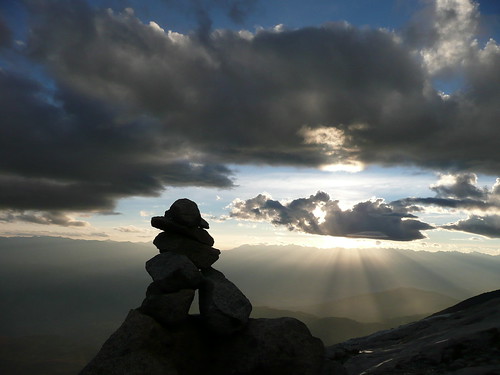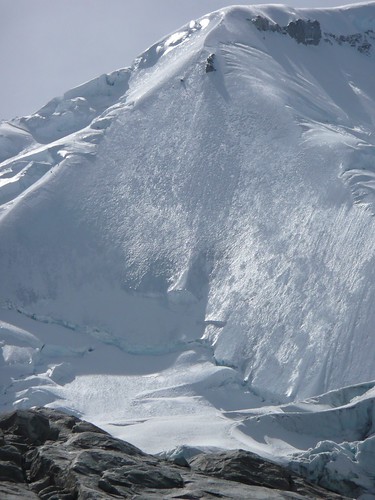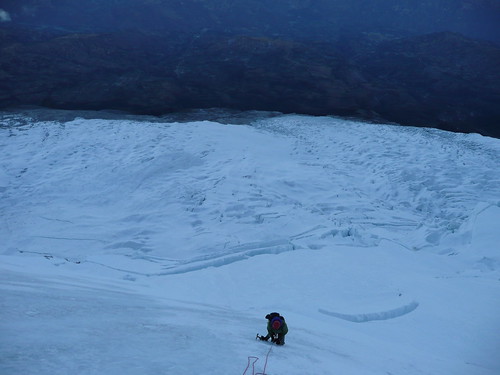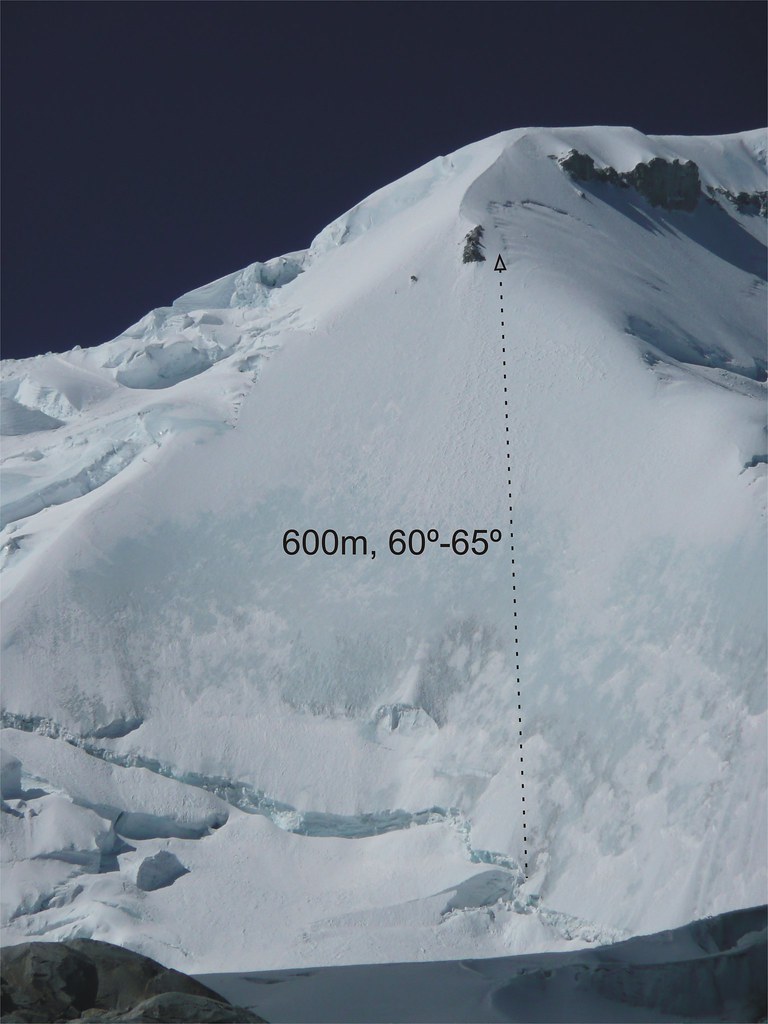Monday, July 16, 2007
The last act: "El Escudo", 8th-13th July 2007 - ENGLISH
Huaraz, 8th July 2007
Ten days of climbing to go. Along the different options we have decided to climb the Huscaran, the highest mountain in Peru, by its West face called locally "El Escudo" ("The Shield"). This ice and snow face own such a name to its very peculiar triangular shape and can be climbed along different lines, the most frequented being the one on the leftest hand side. Our plan is to follow the normal route to the summit untill a altitude of 5900m, then attack the West face and climb about 400 metres at 55-60 degrees.
The "Shield" is a much more technical route than the normal but in itself it is not dangerous and if the weather is fine it will be a very enjoyable climb. Once the West face climbed we will descend the moutain along its normal route.
The ambition is to do everything in four days is pure alpine light style, setting a camp at the limit of the glacier (4800m) and one at the base of the "Shield" (5900m).
This is our last mountain, the last of my ten months' adventure.
Moraine camp (4800m), 9th July 2007
Today has been an hard day. We have left Huaraz in the morning in the direction of the Huscaran. Arrived in Musho, a tiny village at the base of the mountain, we started to hike up in the direction of the glacier's moraine. We arrived to the site selected for our first camp around 5pm. From here we can admire the "Shield" in all its beauty and power. The route normally cimbed is on the left and looks an easy climb, so easy that we wander what justifies the level of D+ (Difficult superior) assigned in our Peruvian climbing guides.

Camp glacier Huascaran (5700m), 10th July 2007
It has just stopped to snow, at least twelve inches in less than two hours. We camped at about 5700, just in the middle of the "Canaleta", a narrow gully just on Huscaran's normal route. The awful weather forced us to stop here. We do not know how fare or close we are from the base of the "Shield". If tomorrow the weather improves we will explore the area around us and climb the face the following day-
In half an hour I think I will get in the sleeping-bag, tomorrow it's another day.
Camp glacier Huascaran (5700m), 11th July 2007
Today bas been a nice day. Around 11am we left our camp to verify what is the most convenient point to start climbing the "Shield". On the left the access seems to be
blocked by a large dimensions crevasse, almost impassable; this makes the easiest route on the face not accessible. On the right it is possible to negotiate the large crevasse passing over a narrow but solid snow-bridge. Perhaps we haven't verified on the left all the possibilities to get to the easiest climbing route on the left. Speaking frankly we are seduced by the possibility to climb the face along a direct, aesthetical, without compromises route. However even if this last option is technically harder (the gradient is at least 60 degrees) it has the advantage to require a shorter approach, about one hour from our current camp. Personally I am convinced it is possible somehow to cross on the left the crevasse but Mike is of the opposite opnion. Doesn't matter, for me it's fine to climb the "Shield" on this direct line. This is the last mountain of my adventure in South America, I want to end well this trip. Tomorrow we plan to wake-up around 2am, leave the camp the latest 3am and around an hour later we expect to start climbing the face.
Huaraz, 13th July 2007
At the end also the "Shield" was climbed but it was not an easy victory. I will carry on myself the consequences per weeks.
Yesterday around 3am we left our camp at 5700m to get one hour later at about 5800m to the site selected to cross safely the large crevasse that traverse on all its lomgitude the West face. All fine in principle, but suddenly we have to face two issues. Mike's frontal lamp does not work correctly and starts flickering turning off at irregular times. We decide, however, to continue; arrived around 4am at the snow-bridge we decide to proceed as follows. I lead the first three pitchs of the climb (for a total of about 150 metres, 450 feet), after that it is will be 6am and there will be enough natural light to allow Mike to climb first. Unfortunately the bad luck is today persecuting us. As soon I start working with my ice-axes and my cromps on the wall MY frontal lamp starts to disfunction. At the minimal move it turns off. I found myself climbing an ice face with a gradient of 70 degrees in the full darkness, with the only company of the cold and the wind at almost 6000m. I manage, however to climb for sixty metres, the total lenght of the rope, placing correctly every ten metres the ice-screws to protect an eventual fall. Mike climbs the second pitch with its lamp that even if disfunctioning it is now better than mine. As soon we finish climbing the third pitch the light of the sun has become strong and we can stop the use of the artificial light. For the following seven hours we continue to climb the acros the six hundred metres of the wall. It is bitterly cold and the sun gets over the ridge only at 11am. The wall is cold, plastered with ice hard but fragile. We need to hammer with all our strenght ice-axes and crampons to penetrate them enough to sustain our weight. The wind blows continously making things certainly not easier.
It is with the biggest relief that just after 11am we got in proximity of the ridge. Just after noon the match is won, the face is completely climbed. About six hundred metres of ice at 70 degrees are below us. We are 6250m, the summit is five hundrerd metres higher. What it remains of the climb is now little more than am easy walk on an a snowy ridge but it would take at least three hours and the descend not less than five. In other words even if we do not take a single break (this si really unrealistic) and not make any mistake we would be back to our camp nto before 8pm. It is clear that allowing a couple of hours for a break and for some navigation's issues we can't be back before 10pm.
Conclusion: getting to the summit is out of question. And very honestly we could not bothered less. What we wanted was to climb the "Shield". The remaining part of the climb is now a walk of very little interest: returning back in the darkness for this is unjustified. Should I write again that our lamps are out of order? There is something else; after eight hours spent climbing on the face both Mitke and I are getting a potential I degree feet frost-bite.
Once the decision taken we quickly climb the ridge up to 6500m; from there it is possible to reconnect to the normal route. We descend it crossing crevasses and traversing sections where the snow gets to our chests. During the descend we realise that it was possible to access to the "Shield" on the left side if we had insisted a bit more exploring in that direction. Who really cares now? When the sun descends on the horizon we are only two hours from our camp. With the light of dusk and of my lamp that now works (bastard!) we get to our tent. It is 8pm, we spent the last seventeen hours climbing without a break, we are exhausted. My feet are are sore, the cold made my toes are black-blueish. Only a massive dose of pain-killers I manage to get asleep.
This morning we left the glacier early in the morning and after and intere day of hiking (from 5,7000 to 3,1000m) we got to the village of Musho and fron there to Huaraz. It has been a hard climb, my feet are sore as never before and I know several weeks - perhaps months - will be needed to recover. I don't mind, my adventure in South America ends with a big victory and even if a bit hurted I return back home safely and in one piece, only one year older.
Huaraz, 14th July 2007
Great: a new route, this is what we probably climbed. We didn't know but we climbed the hardest and most direct route of the entire face. We are verifying is this route had been not climbed before and so fare researchs are negative. May be my adventure in South America ends with the opening of a new route, the dream of any alpinist. This would be the greatest satisfaction even if at the price of a frostbite that will last, in the best of the cases, for a couple of months. Three days remain before my flight leaves Lima for Madrid and from there back to Italy. Seventy-two hours of well deserved rest!
Ten days of climbing to go. Along the different options we have decided to climb the Huscaran, the highest mountain in Peru, by its West face called locally "El Escudo" ("The Shield"). This ice and snow face own such a name to its very peculiar triangular shape and can be climbed along different lines, the most frequented being the one on the leftest hand side. Our plan is to follow the normal route to the summit untill a altitude of 5900m, then attack the West face and climb about 400 metres at 55-60 degrees.
The "Shield" is a much more technical route than the normal but in itself it is not dangerous and if the weather is fine it will be a very enjoyable climb. Once the West face climbed we will descend the moutain along its normal route.
The ambition is to do everything in four days is pure alpine light style, setting a camp at the limit of the glacier (4800m) and one at the base of the "Shield" (5900m).
This is our last mountain, the last of my ten months' adventure.
Moraine camp (4800m), 9th July 2007
Today has been an hard day. We have left Huaraz in the morning in the direction of the Huscaran. Arrived in Musho, a tiny village at the base of the mountain, we started to hike up in the direction of the glacier's moraine. We arrived to the site selected for our first camp around 5pm. From here we can admire the "Shield" in all its beauty and power. The route normally cimbed is on the left and looks an easy climb, so easy that we wander what justifies the level of D+ (Difficult superior) assigned in our Peruvian climbing guides.

Camp glacier Huascaran (5700m), 10th July 2007
It has just stopped to snow, at least twelve inches in less than two hours. We camped at about 5700, just in the middle of the "Canaleta", a narrow gully just on Huscaran's normal route. The awful weather forced us to stop here. We do not know how fare or close we are from the base of the "Shield". If tomorrow the weather improves we will explore the area around us and climb the face the following day-
In half an hour I think I will get in the sleeping-bag, tomorrow it's another day.
Camp glacier Huascaran (5700m), 11th July 2007
Today bas been a nice day. Around 11am we left our camp to verify what is the most convenient point to start climbing the "Shield". On the left the access seems to be
blocked by a large dimensions crevasse, almost impassable; this makes the easiest route on the face not accessible. On the right it is possible to negotiate the large crevasse passing over a narrow but solid snow-bridge. Perhaps we haven't verified on the left all the possibilities to get to the easiest climbing route on the left. Speaking frankly we are seduced by the possibility to climb the face along a direct, aesthetical, without compromises route. However even if this last option is technically harder (the gradient is at least 60 degrees) it has the advantage to require a shorter approach, about one hour from our current camp. Personally I am convinced it is possible somehow to cross on the left the crevasse but Mike is of the opposite opnion. Doesn't matter, for me it's fine to climb the "Shield" on this direct line. This is the last mountain of my adventure in South America, I want to end well this trip. Tomorrow we plan to wake-up around 2am, leave the camp the latest 3am and around an hour later we expect to start climbing the face.
Huaraz, 13th July 2007
At the end also the "Shield" was climbed but it was not an easy victory. I will carry on myself the consequences per weeks.
Yesterday around 3am we left our camp at 5700m to get one hour later at about 5800m to the site selected to cross safely the large crevasse that traverse on all its lomgitude the West face. All fine in principle, but suddenly we have to face two issues. Mike's frontal lamp does not work correctly and starts flickering turning off at irregular times. We decide, however, to continue; arrived around 4am at the snow-bridge we decide to proceed as follows. I lead the first three pitchs of the climb (for a total of about 150 metres, 450 feet), after that it is will be 6am and there will be enough natural light to allow Mike to climb first. Unfortunately the bad luck is today persecuting us. As soon I start working with my ice-axes and my cromps on the wall MY frontal lamp starts to disfunction. At the minimal move it turns off. I found myself climbing an ice face with a gradient of 70 degrees in the full darkness, with the only company of the cold and the wind at almost 6000m. I manage, however to climb for sixty metres, the total lenght of the rope, placing correctly every ten metres the ice-screws to protect an eventual fall. Mike climbs the second pitch with its lamp that even if disfunctioning it is now better than mine. As soon we finish climbing the third pitch the light of the sun has become strong and we can stop the use of the artificial light. For the following seven hours we continue to climb the acros the six hundred metres of the wall. It is bitterly cold and the sun gets over the ridge only at 11am. The wall is cold, plastered with ice hard but fragile. We need to hammer with all our strenght ice-axes and crampons to penetrate them enough to sustain our weight. The wind blows continously making things certainly not easier.
It is with the biggest relief that just after 11am we got in proximity of the ridge. Just after noon the match is won, the face is completely climbed. About six hundred metres of ice at 70 degrees are below us. We are 6250m, the summit is five hundrerd metres higher. What it remains of the climb is now little more than am easy walk on an a snowy ridge but it would take at least three hours and the descend not less than five. In other words even if we do not take a single break (this si really unrealistic) and not make any mistake we would be back to our camp nto before 8pm. It is clear that allowing a couple of hours for a break and for some navigation's issues we can't be back before 10pm.
Conclusion: getting to the summit is out of question. And very honestly we could not bothered less. What we wanted was to climb the "Shield". The remaining part of the climb is now a walk of very little interest: returning back in the darkness for this is unjustified. Should I write again that our lamps are out of order? There is something else; after eight hours spent climbing on the face both Mitke and I are getting a potential I degree feet frost-bite.
Once the decision taken we quickly climb the ridge up to 6500m; from there it is possible to reconnect to the normal route. We descend it crossing crevasses and traversing sections where the snow gets to our chests. During the descend we realise that it was possible to access to the "Shield" on the left side if we had insisted a bit more exploring in that direction. Who really cares now? When the sun descends on the horizon we are only two hours from our camp. With the light of dusk and of my lamp that now works (bastard!) we get to our tent. It is 8pm, we spent the last seventeen hours climbing without a break, we are exhausted. My feet are are sore, the cold made my toes are black-blueish. Only a massive dose of pain-killers I manage to get asleep.
This morning we left the glacier early in the morning and after and intere day of hiking (from 5,7000 to 3,1000m) we got to the village of Musho and fron there to Huaraz. It has been a hard climb, my feet are sore as never before and I know several weeks - perhaps months - will be needed to recover. I don't mind, my adventure in South America ends with a big victory and even if a bit hurted I return back home safely and in one piece, only one year older.
Huaraz, 14th July 2007
Great: a new route, this is what we probably climbed. We didn't know but we climbed the hardest and most direct route of the entire face. We are verifying is this route had been not climbed before and so fare researchs are negative. May be my adventure in South America ends with the opening of a new route, the dream of any alpinist. This would be the greatest satisfaction even if at the price of a frostbite that will last, in the best of the cases, for a couple of months. Three days remain before my flight leaves Lima for Madrid and from there back to Italy. Seventy-two hours of well deserved rest!


